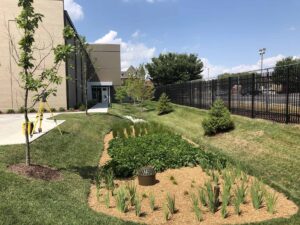Sustainable design principles are an integral component of landscape architecture, guiding the planning, design, construction, and management of landscapes to minimize negative environmental impacts and increase ecological resilience.
Multiple elements can, and are, incorporated into a sustainable design, including thorough site analysis, native plant selection, energy efficiency, and use of sustainable materials. Another key strategy is water conversation and management. This approach can involve rainwater harvesting, permeable paving, bioswales, green roofs, and drought-tolerant plants. Use of these tactics help recharge groundwater, mitigate flooding, and improve water quality.
A water conservation method often employed by Cole’s landscape architecture team is building bioretention basins. Often referred to as a rain garden or a bioinfiltration basin, it is a human-made or modified depression in the ground designed to capture and treat stormwater runoff. It mimics natural processes to manage stormwater and promote groundwater recharge.
Here is how it typically works:
-
Collection: Stormwater runoff from impervious surfaces like roads, driveways, and rooftops is directed into the bioretention basin.
-
Filtration: The basin is filled with various layers of vegetation, soil, sand, and gravel. These layers help filter out pollutants such as sediment, nutrients, heavy metals, and oil from the runoff.
-
Absorption: The filtered water is then absorbed by the soil and taken up by the plants in the basin. This process helps to reduce the volume of stormwater runoff and promotes groundwater recharge.
-
Treatment: Microorganisms in the soil and roots of the plants help break down pollutants, further treating the water before it enters groundwater or nearby water bodies.
Bioretention basins provide multiple benefits, including the mitigation of flooding and erosion, improving water quality, enhancing wildlife habitat, and adding aesthetic value to the landscape. Compared to traditional stormwater management systems, bioretention basins require fewer resources to construct and maintain. They utilize natural processes for stormwater treatment and do not rely on energy-intensive mechanical systems, resulting in lower operational costs and reduced environmental impact over their lifecycle. They are commonly used in urban and suburban areas as part of stormwater management systems to mitigate the impacts of development on natural hydrological processes.

The Cole Planning and Landscape Architecture team is experienced and ready to solve your specific landscaping challenge. Visit colestl.com/services/landscape-architecture for more information or to connect with an expert today.
